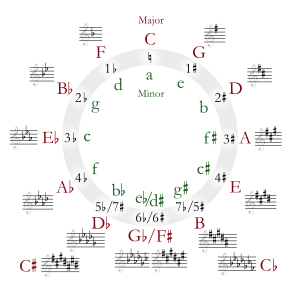F-sharp major facts for kids
 |
||
| Relative key | D♯ minor | |
|---|---|---|
| Parallel key | F♯ minor | |
| Notes in this scale | ||
| F♯, G♯, A♯, B, C♯, D♯, E♯, F♯ | ||
F-sharp major is a type of musical scale. It starts on the note F-sharp. Think of a scale as a special ladder of notes.
This scale has a unique key signature with six sharps. Sharps tell musicians to play a note a little higher. F-sharp major also has a "relative minor" scale, which is D♯ minor. This is like a cousin scale that shares some notes. It also has an "enharmonic" twin, G♭ major, which sounds the same but is written differently.
Contents
Where F-sharp Major is Used
F-sharp major is not often used in music played by a full orchestra. When it is used, it often helps the music to change keys. This is called modulation.
This key is more common in piano music. For example, the composer Alexander Scriabin used it in some of his sonatas. Sometimes, if piano music in F-sharp major is changed for an orchestra, it might be rewritten in a simpler key like F major or G major.
If F-sharp major must be used for an orchestra, special transposing instruments like the B-flat clarinet need their music written in A-flat major. This helps them play the correct notes.
Famous Pieces in F-sharp Major
Many famous composers have used F-sharp major in their music:
- The "Presentation of the Rose" scene in Act Two of Richard Strauss's opera Der Rosenkavalier is in F-sharp major.
- Ludwig van Beethoven used this key for his Piano Sonata, Op. 78.
- Frédéric Chopin's Barcarolle is also in F-sharp major.
- Franz Liszt's Hungarian Rhapsody No. 2 uses this key.
- Gustav Mahler's unfinished Tenth Symphony is in F-sharp major.
- Erich Wolfgang Korngold wrote his Symphony Op. 40 in this key.
- Alexander Scriabin's Fourth Sonata also features F-sharp major.
How it Looks on Sheet Music
Sometimes, when F-sharp major is written for the bass clef, the sharp sign for the note A is placed on the top line of the musical staff.
| Diatonic Scales and Keys | |||||||||||||||||||||||||||||||||||||||||||||||||||||||
|---|---|---|---|---|---|---|---|---|---|---|---|---|---|---|---|---|---|---|---|---|---|---|---|---|---|---|---|---|---|---|---|---|---|---|---|---|---|---|---|---|---|---|---|---|---|---|---|---|---|---|---|---|---|---|---|
|
|||||||||||||||||||||||||||||||||||||||||||||||||||||||
| The table shows the number of sharps or flats in each scale. Minor scales are written in lower case. | |||||||||||||||||||||||||||||||||||||||||||||||||||||||
See also
 In Spanish: Fa sostenido mayor para niños
In Spanish: Fa sostenido mayor para niños


